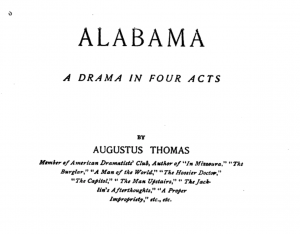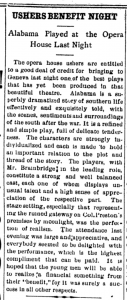SMITH HISTORY BLOG: Alabama in New York
By Chris Woodworth
Looking over old programs and newspaper articles about the performances on the stage of The Smith in its early years, two tropes emerge. First, American theatre audiences were clearly drawn to hurtful racist depictions as the sheer number of productions that featured the use of blackface or yellowface illustrate. (We’ll tackle that in greater detail in a later blog.) Second, theatre producers were continuously looking for innovative gimmicks to pull in audiences. An April 1896 performance of a melodrama called ‘Alabama’ appeared to feature both tropes. ‘Alabama’ premiered in New York City at the Madison Square Theatre in

Title page from the 1900 publication of Alabama. Note that the date of the original production is incorrect. ‘Alabama’ premiered in New York City in 18 91, not 1890.
3. Geneva Daily Times article following the usher benefit performance of ‘Alabama
April 1891.
The play was written by Augustus Thomas, a playwright who has largely disappeared into obscurity but who, in his era, was hailed by some as “the greatest dramatist we have” (“Topics of the Theatre” 379). Thomas strove to create a sense of “atmosphere” in his plays, many of which were set in a fictionalized version of the South. As one critic noted, however, “‘Alabama’ had too much atmosphere and too little action” (379).
Act III of ‘Alabama’ is set at the “Ruined Gateway” of the Preston family home, with moonlight shining down. To further set the atmosphere of this “moonlight and magnolia” moment during the 1896 performance at The Smith, the auditorium was pumped with perfume, provided by the local druggist, W.H Partridge, whose shop was a nearby Seneca St. neighbor.
Theatre historians have contended that Thomas’s play, which is set in the post-Civil War South focuses on “the spirit of reconciliation and romance, not upon any problems besetting the new south” (Miller 256). As with many plays of this period that depict the Civil War or post-Civil War era, racial tensions and the traumas of chattel slavery are erased in favor of depicting grotesque stereotypes of the “happy slave” (or, in this case, former slaves), played by Caucasian actors in blackface.
These depictions were clearly alluring to audiences as ‘Alabama’ ran for several years in New York City before touring throughout the country. An added draw for Geneva audiences was that the performance was a special benefit for the ushers, meaning that they would have been given a cut of the proceeds for that night’s performance. Indeed, as the Geneva Daily Times attested the next day: “The attendance last night was large and appreciative […] It is hoped that the young men will be able to realize a financial something from their ‘benefit,’ for it was surely a success in all other respects” (“Usher Benefit” 4).
Miller, Tice. “Plays and Playwrights: Civil War to 1896.”
The Cambridge History of American Theatre: Volume Two, 1870-1945, edited by Don B. Wilmeth and Christopher Bigsby, Cambridge UP, 1999, pp. 233-261.
Program from ‘Alabama,’ Geneva Historical Society Archives.
Thomas, Augustus. Alabama: a Drama in Four Acts. R.H. Russell Publisher, 1900.
“Topics of the Theatre.” Ainslee’s Magazine, vol. 5, no. 4, May 1900, pp . 379-384.
“Usher Benefit Night.” Geneva Daily Times, 29 April 1896, p. 4.
